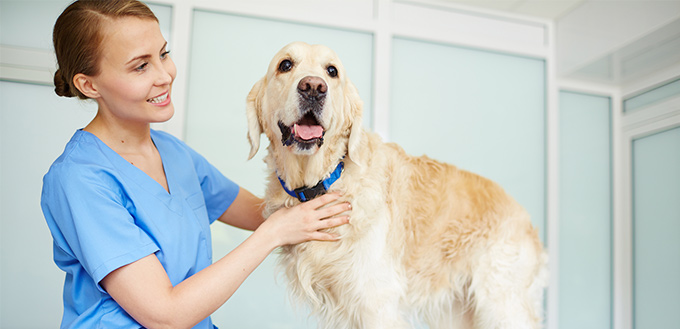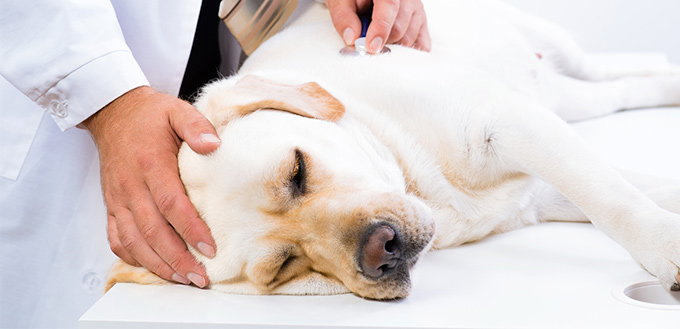Just like their pet parents, dogs can get hernia, too. Hernia in dogs can be due to injuries or a metabolic abnormality that causes a certain section of the dog’s abdominal wall to weaken. Or it could be congenital. And since the abdominal cavity is actually crammed with a lot of organs and tissues, one can only imagine what will happen next if this weak spot suddenly bursts open. The bad news is that there are some types of hernias in dogs that are definitely life-threatening. The good news, however, is that they can be treated but will require prompt recognition of the symptoms so that appropriate treatments will be instituted at once.
Defining Hernia
Hernia is roughly defined as the outpouching of abdominal contents through the wall of the abdomen. These can include fatty tissues and abdominal organs that push their way through a weakened spot in the abdominal wall. Over time this weakened spot can break, creating a hole.
If it is small enough, only fatty tissues may protrude through the wall. This can be easily remedied by the careful and gentle application of pressure to push the fatty tissue through the hole and back within the abdominal cavity.
If the hole happens to be big enough so as to allow sections or organs like the intestines or the colon to push through the abdominal wall, there is a possibility that the narrowed passage can constrict blood vessels in these organs. This restricts blood flow and can lead to the loss of the organ.
Prompt recognition of the presence of hernia begets prompt treatment, averting organ loss. That is why it is important to learn how to recognize the symptoms of hernia in dogs.

Types of Hernias
Dogs can have one of 5 different types of hernias. They are as follows:
- Hiatal
The esophageal hiatus is a natural opening located in the diaphragm of a dog through which the esophagus passes to join the stomach. It is also through the esophageal hiatus that the vagus nerve passes. In hiatal hernia, the upper section of the stomach pushes itself through this small natural opening. It can compress the esophagus as well as the vagus nerve.
- Diaphragmatic
The diaphragm is that special layer of muscle that separates the thoracic cavity, where the heart and lungs are located, from the abdominal cavity. Its principal function is in respiration. When it contracts, it expands the thoracic cavity to reduce the pressure within the pleural space. Since there is lower air pressure in the lungs, air from outside the dog’s body goes in.
Unfortunately, if a hole develops in this layer of muscle, the abdominal organs pushing through the hole can significantly affect the process of respiration. Your dog will have difficulty or labored breathing. It can also compress the heart, leading to more serious problems.
- Umbilical
Among puppies, umbilical hernia is quite common. This is mostly congenital in nature and results in the protrusion of the umbilicus through the abdominal wall. It is easily identifiable since you can feel a lump on your puppy’s belly button. The good thing is that most umbilical hernias resolve on their own. In some instances, however, surgery may be needed to fix the problem, but only when the dog has already been neutered or spayed.
- Perineal
The perineum is the opposite of the diaphragm, forming the lower border of the abdominal cavity. It is the demarcation line between the abdominal cavity and the pelvic cavity. In such cases, the sigmoid colon or any other abdominal organ or tissue can push itself through the perineum and compress the organs in the pelvis adjacent to the rectum and anus such as the urinary bladder. This can lead to problems in urination. It is typically seen in unneutered dogs older than 5 years.
- Inguinal
The last type of hernia in dogs is inguinal, which is the groin of the dog. The small and large intestines, urinary bladder, or even the uterus can push themselves through the weakened muscles of the groin, strangling and cutting off circulation to these organs. This type of hernia in dogs is mostly congenital in nature, although it is typically seen in dogs that are pregnant as well as in their middle ages.
Causes of Canine Hernia
There are two principal causes of hernias in dogs. The first one is congenital, meaning the dog was already born with the condition. It is the most common cause of hernia found in younger dogs and is often the result of a problem during embryonic and fetal development. It is also possible that a genetic defect has been passed down from one of the progenitors of the dog.
Existing literature show that certain breeds of dogs have a higher risk of developing certain types of hernia, further cementing the idea of genetic inheritance as a means of disease causation. English bulldogs and Shar-peis as well as other brachycephalic breeds are known to be more vulnerable to hiatal hernias while Weimaraners and Cocker spaniels have increased predisposition to diaphragmatic hernias.
The second cause of hernia is trauma or injury. Blunt force injuries to the abdomen can weaken the musculature of either the diaphragm or the perineum or even the abdominal wall itself. An increase in intraabdominal pressure is also seen by experts as one of the possible causes of herniation since an increase in the pressure within the abdominal cavity can push internal organs and other structures against the wall of the abdomen. However, the pressure should be sufficient enough to push these organs through.

Clinical Manifestations of Canine Hernia
As we have already mentioned in our discussion of the different types of hernia in dogs, the clinical manifestations observed in canines with the condition are actually related to the organ that is being constricted. Generally, however, the manifestations you have to watch out for include the following.
- Pain
- Lack of appetite
- Vomiting
- Palpable mass or lump in the dog’s abdomen
- Coughing
- Difficulty breathing or labored breathing
- Shortness of breath
- Difficulty urinating
- Irregular heartbeat
- Drooling
For dogs with hiatal hernia shortness of breath, difficulty swallowing, acid reflux, regurgitation of food, vomiting, and chest pain are very common. Dogs with diaphragmatic hernia will often show very fast breathing and heartbeat, difficulty breathing, bluish discoloration of the skin and mucus membranes, and an abdomen that looks like it is caved in.
Dogs with umbilical hernia may often present with constipation, vomiting, tenderness in the abdomen, redness in the umbilical area, and a palpable mass within the umbilical region. Canines that are suspected of having perineal hernia will show signs of weakness or lethargy, difficulty passing stools, difficulty urinating, and visible swelling within the area of the rectum. It is also possible for the dog to have a different orientation or movement of its tail.
Dogs that are suspected of having inguinal hernia typically present with bloody urine, increased frequency of urination, passing very scant urine, swelling on either of the groins, and depression.
Diagnosing Hernia in Dogs
One of the most definitive ways to diagnose hernia is the palpation of a soft mass in areas where there normally shouldn’t be. However, most vets would still want to be sure that what they are seeing and palpating is actually herniation and not another disease condition. As such, an x-ray of the affected area can help visualize the placement of the herniation and whether it is located deep within the abdominal cavity of the dog or not. This will also allow vets to visualize the best approach if ever the herniation requires surgical correction.
In most instances, a contrast media is introduced to the digestive tract of the dog before x-ray. This is to turn the digestive tract and its associated organs into opaque upon x-ray examination. Since they are now opaque it is a lot easier to follow their outline in the dog’s abdominal region and determine if something is out of place.
The diagnostic imaging tests will then be compared with the results of the physical examination as well as the dog’s history of clinical manifestations. The different manifestations should match well with the location of the hernia to make for a more compelling, more definitive diagnosis.
To make sure your dog is fit for surgery, a series of tests and diagnostic exams can be ordered by the veterinarian. These can include blood count and blood chemistry tests as well as electrolyte panels. Blood chemistry is important since it provides a rough estimate of pancreatic, liver, and kidney function as well as a fair idea of glucose metabolism. Blood counts provide a basis for the identification of blood-related disorders which might impact surgical wound repair and healing.

Canine Hernia Treatment
Since the principal pathology in hernia is the creation of a hole in a wall inside the dog’s body, only surgical correction can help push back the organs and tissues that may have already protruded through this hole and to surgically close the hole. However, not all hernias should be treated with surgery since there are those that typically resolve on their own.
Hernias with rather small openings do not necessarily require surgery as careful manipulation of the area can help replace protruding tissues back into the abdominal cavity. However, since the hole is still present, surgery may still have to be performed sometime in the future. For instance, umbilical hernias, while they resolve without surgery, may be surgically repaired only after the dog has been neutered or spayed.
In addition to surgery, the vet may also provide symptomatic treatment. For example, if there is acid reflux as a result of hiatal hernia, antacids may be prescribed. Antiemetics may also be given in cases of vomiting as well as analgesics for pain.
In cases of hiatal hernia or diaphragmatic hernia that is complicated by pneumonia, it is possible that vets will order the appropriate antibiotics. It is imperative that the recommended antibiotic dosing be adhered to.
Prevention of Canine Hernia
It is possible to prevent hernia in dogs. While there really is no 100% way to prevent all types of hernia from developing, there are several ways in which you can help protect your dog against this condition.
Spaying and neutering have been regarded as two of the most effective ways to prevent inguinal and perineal hernias. Having your dog neutered or spayed can thus help minimize their risk of developing these two types of herniation.
Since all 5 types of hernia in dogs are congenital in origin, one way to avoid this is by providing your dog with the best possible nutrition for its breed, lifestyle, and size. This should help reduce hernia risk onto their puppies should they become pregnant. Brachycephalic breeds and dogs that are known to be at an increased risk for developing hernias should not allowed to breed since there is a very strong chance they will be passing the genetic defect onto their offspring.
Supporting Dogs with Hernias
From the time dogs are diagnosed with hernia until several months after the surgical repair of the hernia, it is imperative that pet parents support their dogs. An increase in intraabdominal pressure can further worsen the hole in the wall. Strenuous activities including vigorous exercises and plays should be minimized at all costs. Protecting pets from further injuries to their abdomen can also help.
After surgical repair of the herniation, the dog should be well-rested to help facilitate healing of the surgical wound and to prevent abnormal increases in intraabdominal pressure. Bloating should be avoided as this can put a strain on the just-repaired hole in the abdominal wall. Small frequent feedings work best in such situations.
Hernia in dogs can be a very simple bulge in their abdomen. Or it could easily turn out life-threatening especially if the protruding organs are already being cut off of their blood supply due to strangulation by the hole. The good news is that the sooner hernia is diagnosed in your dog, the sooner will the appropriate treatments be applied. Sooner or later your dog will be able to resume its normal activities of daily living.
Sources:
- Dr. Jessica Vogelsang, Hernias in Puppies: What You Need to Know, PetMD
- Hernia in Dogs, Pet Health Network
- Hernia in Dogs, WagWalking
Note: The advice provided in this post is intended for informational purposes and does not constitute medical advice regarding pets. For an accurate diagnosis of your pet's condition, please make an appointment with your vet.






